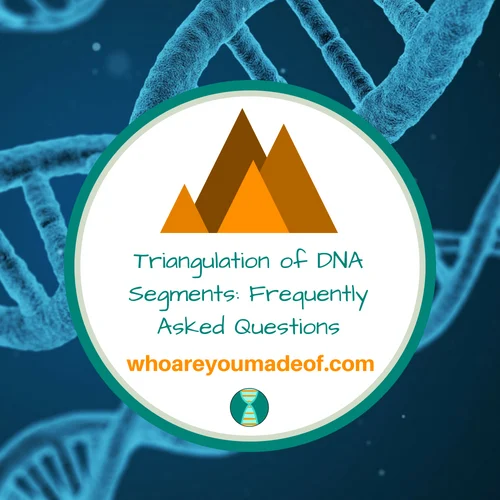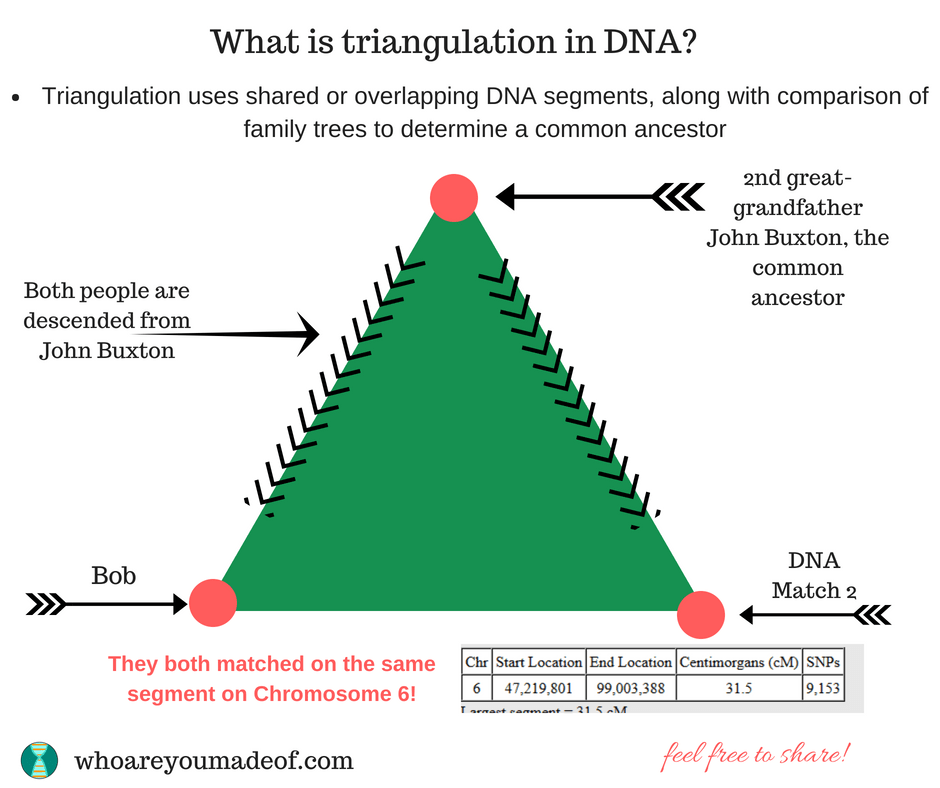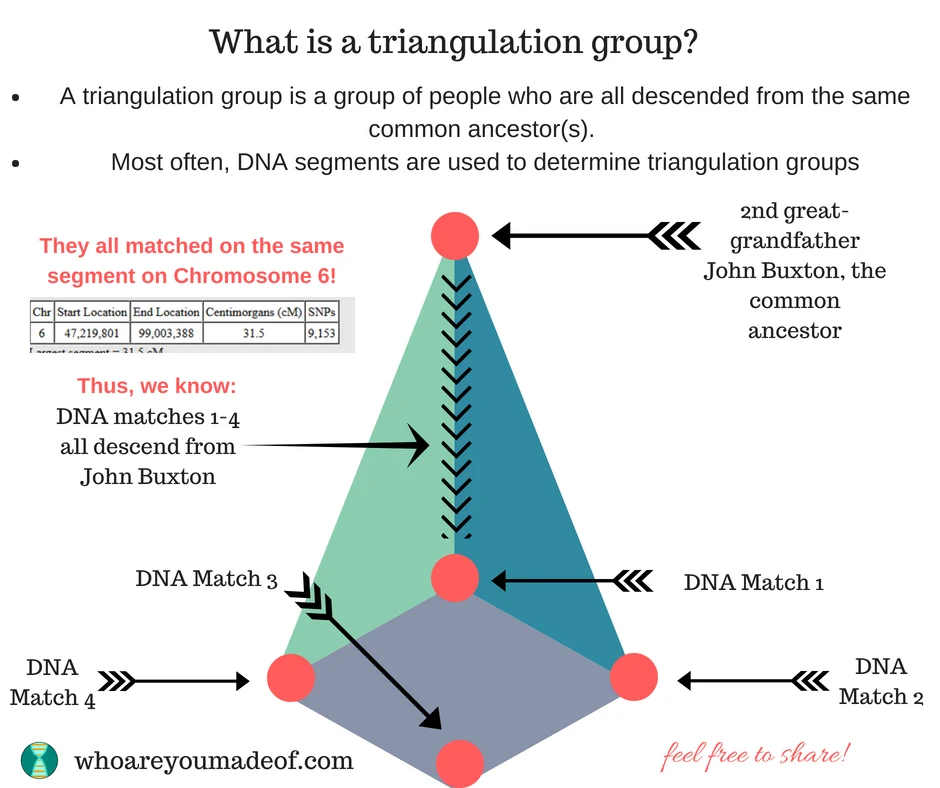In this post, you will find the answers to the most frequently asked questions about triangulation. Triangulation is a really great strategy for getting the most from your DNA results.
Maybe you've already heard of triangulation, but you don't know how to do it, or what it really means. No matter what you already know about the topic, you'll be sure to find new ideas here.

If you don't see your question about triangulation here, please add it to the discussion below - I might add your question to the post!
What does triangulation mean?
The term triangulation is used in many fields, but in genetic genealogy it has a very specific definition. Triangulation uses information obtained from comparing the DNA results of two related individuals and careful analysis of both of their family trees with the goal of determining the common ancestor.
Triangulation, when done correctly, can provide "proof" that two people are descended from the same ancestor, and exactly which DNA segment (or DNA segments) can be attributed to that ancestor.
The image below might help you visualize the process of triangulation.

It's important to mention that viewing your Shared Matches (or matches in common) with a particular match is not the same thing as triangulation.
There is always a chance that you, your DNA match, and your shared matches are related in a different way, on different lines of your family. The only effective way to use triangulation is using DNA segments.
What is the point of triangulating DNA segments?
As I mentioned before, if triangulation is done correctly, you will be able to figure out exactly which ancestor passed down a particular DNA segment to you and your DNA matches. Triangulation is also very helpful when it is used along with chromosome mapping (it sounds technical, but it's totally doable, I swear!).
When you have completely mapped your chromosomes, you know exactly which DNA segment you inherited from any given ancestor. This means that when you get a new DNA match, you will be able to quickly identify your common ancestor, even if your match doesn't have a complete family tree.
Note: Chromosome mapping is very easy to do with the free tool, DNA Painter, which I mention again at the end of this post.
What is a triangulation group?
A triangulation group is a group of people (at least three) who all share a common DNA segment or an overlapping DNA segment. The idea is that everyone who is a member of the triangulation group might be descended from the same common ancestor.
The image below depicts a triangulation group. There are four members of this triangulation group, since they all shared an overlapping segment on Chromosome 6, and they are all descended from the same man, John Buxton, who happens to be the great-great grandfather of all of the members of this fictional triangulation group.

What information do you need to start triangulating DNA segments?
In order to begin triangulating your DNA segments and finding relationships with your matches, you will need to have access to a chromosome browser, or specific data about the DNA segments that you share with your DNA matches.
Important Note: It's important to note that in order to effectively triangulate your matches, you will need to know if your DNA matches are paternal or maternal. This is because we actually have two copies of each chromosome, and you need to know which copy of the chromosome your DNA match matches you on.
You can figure this information out by only using phased matches (matches that have already been determined to match on one side or the other of your family), Shared Matches, or matches in common (FTDNA).
Which websites provide chromosome browser information to use with triangulation?
Family Tree DNA, My Heritage DNA, and 23 and Me all provide a chromosome browser. Gedmatch, a free website allowing access to DNA analysis tools, also has a chromosome browser.
Ancestry DNA does not have a chromosome browser, and does not provide access to information about DNA matches on the chromosome level, but you can always download your DNA from Ancestry and transfer it to the following sites:
- Gedmatch
- FTDNA
- My Heritage DNA
Can you use triangulation for close and distant DNA matches?
You can triangulate both close and distant DNA matches. It's easier to do with relatively close DNA matches, since most people have a good idea as to who their recent ancestors are, and there is a better chance that a relatively close DNA cousin has a family tree big enough to match with yours.
With that said, it is still possible to triangulate with very distant cousins, as long as you have patience and access to big enough family trees.
Does the size of the DNA segment matter with triangulation?
It doesn't matter how big the DNA segment is that you would like to triangulate, with one caveat. The smaller the DNA segment, the higher the possibility that the DNA segment in question is "identical by state", or coincidentally identical, as opposed to identical-by-descent.
We only want to examine segments that are identical-by-descent, since that means that we inherited the segment from a common ancestor.
Furthermore, the smaller the segment, the more distant the common ancestor, and the less likely it is that you will be able to find a common ancestor in the respective genealogies.
Most experts don't recommend attempting to triangulate segments smaller than 10 centimorgans (cMs). You'll have the best luck with segments that are at least 10 cMs in size.
Does everyone who matches on the same DNA segment share a the same common ancestor?
Generally speaking, yes. As long as you are sure that all of your DNA matches match you on the same side of your family (i.e. paternal or maternal), then yes, all of your matches that overlap on the same segment are descended from the same ancestor.
There are a few exceptions:
- Coincidentally identical segments (identical-by-state) frequently occur, especially small ones
- With distant cousins come an increased chance that you are related on both sides of your family, especially if your parents have common ancestry (i.e. British/German/Mexican), and so the more distant the cousin, the less likely you can be absolutely sure that it is a paternal or maternal match
What does it mean if the DNA segments that a triangulated group shares overlap, but don't have the exact start and end positions?
As long as the overlapping segments have significant overlap, then there is no significance in having different start and end positions. Reasons for this could be as simple as all of the members of the triangulation group tested with a different testing company (slightly different methodology), or that each match inherited a slightly different DNA segment from their parent on that line.
What is the difference between a half-identical and a fully-identical DNA segment?
You will only share fully identical regions with your closest relatives. Generally speaking, triangulation is most commonly used with half-identical segments. Full identical segments are segments that are identical on both copies of your chromosome.
You inherited one copy of each chromosome, so you can only share legitimate fully-identical regions on your chromosomes with people who are related to both of your parents (i.e. siblings).
Where is the best place to organize and keep track of triangulated DNA segments?
I know that some people have been triangulating segments and mapping chromosomes for a long time and have used spreadsheets (or even notebooks!), but I have found that the easiest way is to use DNA Painter.
It's a totally free website where you can individually "paint" DNA segments into your chromosomes - the same idea as chromosome mapping, but more visually appealing than a list on a spreadsheet.
To be honest, DNA Painter makes chromosome painting fun. It has quickly become one of my favorite tools.
Conclusion
I hope that this post helped clear up some of your basic questions about triangulation. If you have experimented with triangulation, or if it has helped you solve a mystery in your family tree, I would love to hear from you in the comments.
Thanks for stopping by!
